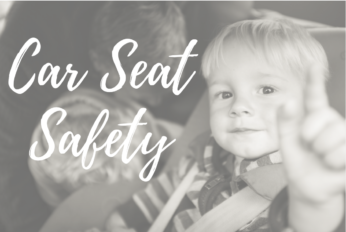Baby On Board: Driving Safely With Little Ones
Over 128,000 children ages 0-12 are injured in a vehicle each year. Baby car seat placement is so important. Luckily, there are many things you can do to keep your child safe and sound. While most people are at least moderately familiar with car and car seat safety for older children, many are unaware of the differences for babies in vehicles and baby car seats. Just by taking some time to familiarize yourself with travel safety for little ones, you’re stepping up your safety with awareness. Whether you’re just taking a quick trip to the grocery store, or you’re traveling for vacation, keep this baby-specific safety information in mind.
Use the Right Safety Seat
The type of baby car seat required depends on your child’s size as well as what kind of vehicle you’re driving. There are tons of car seats on the market, so finding the right one can be a challenge. Before you make a final decision on your purchase, be sure that you’re selecting the perfect seat for your baby by going over the guidelines for infant car seats set forth by The National Highway Traffic Safety Administration.
Fitting The Seat Correctly
Once you’ve found the right seat, there are still important things to remember to secure the seat correctly. Infants to children 2 years of age should always be in a rear-facing seat, so that their head, neck, and spine are all safely cradled and supported. Babies (and children) should always be secured in their car seat located in the back of the vehicle, as airbags in the front seat are meant for adult bodies. Securing your baby in their safety seat is also important. The harness should be tight enough so that you can’t pinch any folds in the straps after they’re buckled in, but not so tight that it’s uncomfortable or pressing tightly into them. Keep the safety straps straight and free from twists, knots, or sagging. The top of the chest clip should be located level with their armpits.
Dressing Your Baby For The Car
Finally, another common mistake is made in effort to keep babies warm and comfortable, and that’s how they’re dressed, as well as the use of blankets. Don’t dress your child in very bulky clothes for warmth, as this can interfere with the straps in the car seat. You also should never put a blanket between the child and the straps, or underneath the little one. To keep your baby warm, place a warm blanket over the top of them once they are already safely secured.
Consider the Weather
Hyperthermia (not to be confused with hypothermia) is a dangerous condition that occurs when the body rises to a temperature above 104 degrees fahrenheit as the result of an excessively hot environment. Typically the body perspires to keep itself at a safe temperature, but in certain conditions like inside vehicles, it’s unable to cool itself enough or quickly enough. It’s dangerous for children, pets, or people of any age to be left inside a hot vehicle, but babies are especially vulnerable to heat-related illness (come to think of it, this applies to pets too). Babies are unable to cope with high temperatures, plus they are not able to voice their discomfort the way a toddler or older child can, so even placing them in a hot car while you’re driving isn’t ideal. If it is a particularly hot day, it’s best to start your car and use the air conditioning to cool it down before placing your baby in their car seat.
If your vehicle doesn’t have air conditioning, open the doors to your car and allow it to ‘air out’ for a few minutes to dissipate as much of the accumulated heat inside of it as possible. Once you’re reading to drive, keep windows down to allow further cooling. Lastly, always remember that it is never ok to leave babies, children, or pets unattended in a vehicle (you should also consider the safety for disabled adults and seniors; really, staying in hot- or cold- vehicle isn’t safe for anyone), not even for a short moment. If you ever see a child or pet alone in a hot car, please contact your local authorities for help.
Use Common Sense
Other things, like distractions, also contribute to unsafe driving. Don’t worry, though, it’s easy to remedy. Always place your phone where it won’t be a distraction, and avoid eating while driving; done and done, right? Make sure your child is safely secured in a proper car seat, address the temperature (whether hot or cold), do a head count if you have multiple children, and avoid distractions. Lastly, be consistent with your rules for your children in vehicles, and be sure anyone that may have your kids in their vehicle under their care follows the same guidelines for safety. Consistent rules means consistent safety. Follow this checklist, and you’re good to go!
Jennifer Ipsen is writer for Best Convertible Carseats. For more reviews and information on baby car seat placement, you can view her writings here www.parent.guide/best-convertible-car-seats/





















